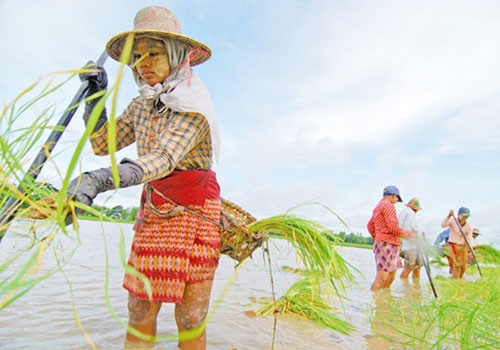Myanmar: Rice export behind target, to focus on quality
The rise of the US dollar value in currency exchange markets is leading to an increase in rice export volumes when compared to the previous financial year, said U Ye Min Aung, managing director of Myanmar Agribusiness Public Corporation (MAPCO) and the general secretary of the Myanmar Rice Federation (MRF).

Farmers prepare paddy field for rice harvest. Kaung Htet / The Myanmar Times
According to figures up until March 3, Myanmar’s rice export has risen by about 25,000 tonnes compared to the export volume in the fiscal year 2015-16, he said. This year’s rice export is likely to go up to nearly 1.5 million tonnes, he also said at a course-completion ceremony on rice export sector held on March 13.
Unfortunately, MRF’s initial expectation to export about 2 million tonnes of rice for this fiscal year seems unlikely to be met.
“We can export about 1.5 million tonnes this year. This situation shows that the supply of rice is sufficient for domestic consumption … and demands from Sri Lanka and China are also increasing. But the most important part is that the exchange rate helps exporters produce healthy profits and pushes them to export more,” said U Ye Min Aung.
In this financial year, the exchange rate for the US dollar rose to K1400 and K1365 on March 13. This fact encourages rice exporters to export more rice, he said.
In the last fiscal year, Myanmar exported 1.473 million tonnes of rice but this year’s export has reached about 1.498 million tonnes, roughly totalling US$700 million.
China is beginning to thoroughly examine rice being exported across the border this fiscal year –exporting rice across the border area is on the decline. In the past, annual rice exported through the border area was more than 900,000 tonnes. This fiscal year, the cross-border export was only 600,000 tonnes and 100,000 tonnes through shipping containers, said U Toe Aung Myint, permanent secretary of the Ministry of Commerce.
According to cross-border export data, in the past two fiscal years there were roughly 12.2 million tonnes of rice exported for 2015-16. 240,000 tonnes of that amount were done through shipping containers in the fiscal year 2015-16. For 2014-15, there were more than 18 million tonnes of rice, 5 million tonnes of which were also exported through shipping containers in that year.
“After improving the private sector, rice export is mainly for cross-border export. In this year, exporting through shipping containers is increasing by connecting individual entrepreneurs,” he said.
In the fiscal year 2016-17, shipping exports was nearly 600,000 tonnes and cross-border trade fell to about 900,000 tonnes.
The MRF is expecting to reach US$1 billion from the rice sector in 2020. The sector can grow and increase the revenue by exporting high quality rice, said U Ye Min Aung.
“For our objective and vision in 2020, by then between US$35 million and US$40 million should be achieved by exporting quality rice … We will improve our revenue by focusing on quality and exporting qualified rice instead of boosting the quantity of exports,” he added.
Myanmar legally exports to China through shipping on the basis of a quota system since the fiscal year 2014-15. Now, the amount of export is nearly 200,000 tonnes, according to the legal contract, and the signing of new contracts this month will amount to an export of 100,000 tonnes, he said.
However, exports according to the contract can only take place in the upcoming fiscal year.
Myanmar has no well-established export market for rice apart from China, but that country’s crackdown on illegal importshas left Myanmar with a growing surplus of unsold paddy.
A potential export agreement with the Philippines in 2015 fell through, mainly because Myanmar rice proved too expensive and so the Philippines decided to make a deal with Vietnam instead. Attempts to renew a memorandum of understanding with Indonesia are still under way and have not yet finalised.
U Khin Maung Lwin, deputy secretary at the commerce ministry, told the Myanmar Times back in November 2016 that the government was pursuing exports to the EU and Indonesia, and trying again to form an agreement with the Philippines. He was hopeful that it would not take long for the Indonesia agreement to finalise.
In November, the Myanmar Times reported that MAPCO signed an agreement worth around US$3 million with South Korean firm SK networks to import 100 grain dryers for rice and corn. The dryers would go to the agribusiness service centres MAPCO was in the process of setting up in Yangon, Mandalay and Ayeyarwady regions.
Source: http://www.mmtimes.com/index.php/business/25404-rice-export-behind-target-to-focus-on-quality.html


 Thailand
Thailand




